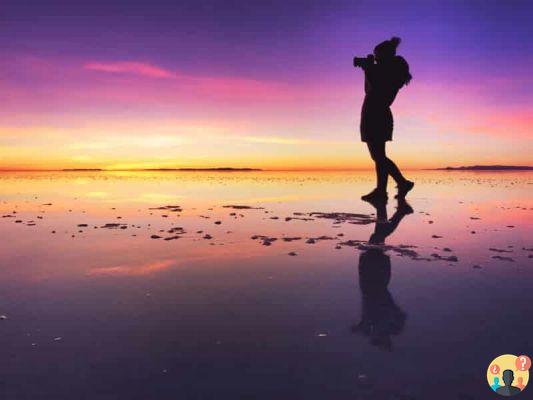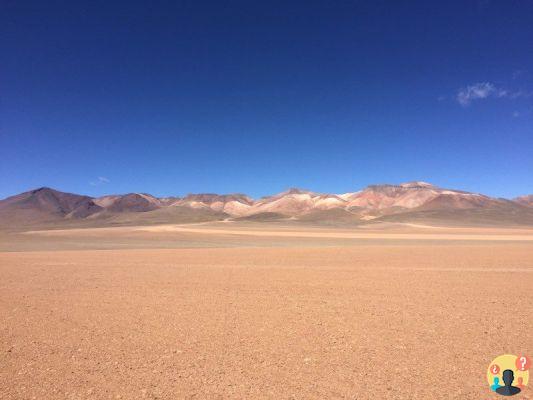Everything you need to know before traveling to the largest salt desert in the world and what to take to Salar de Uyuni to enjoy your trip in the best way without getting into a cold!
The first time I heard about the Uyuni Salt Flats it was over 10 years ago, when the internet was still in its infancy and it was almost impossible to find any information on how to get there, What to bring to Salar de Uyuni and how to plan for the trip.
I remember like it was today that I fell in love with the few photos I found, I wrote down that name in a notebook so I wouldn't forget it and, since then, I've had this dream in my head of one day getting there.
A few years later, the Uyuni Salt Flats became a popular destination among Brazilians doing the first backpack and I confess that I lost the charm with this place after that untouched paradise of my dreams became popular on the internet in funny perspective photos. I felt that regret for not having ventured out at the time of scarce information and fear that the energy of the place had already changed due to excess tourism…
My mistake! It was with tears in my eyes that I arrived at this destination that I had been waiting for and today I am the one who comes here to tell you how to make your experience even better with simple tips on how to program and What to bring to Salar de Uyuni.

WHAT TO BRING TO SALAR DE UYUNI:
It is essential to take into account that you will be traveling through a region of extremes when choosing What to bring to Salar de Uyuni.
Cold, heat, rain, sun, snow, ice, altitude… all this can be present in your trip with a drastic difference in just a few minutes. An excellent recommendation, for example, is the 3-in-1 jackets from Columbia, perfect for places with variable weather like the Salar de Uyuni.
Therefore, I will leave here a list of essential items in your backpack so that you can face all these conditions without going through too much trouble.
CLOTHES:
– I would love to be more practical in this matter, but you will have to bring practically any type of clothing for this trip as the temperature difference can vary a lot, from minus degrees to 40 degrees in a matter of minutes.
– Avoid clothes that you are sorry to stain or dirty because salt is bad for clothes.
– Slippers for walking on the Uyuni Salt Flats and avoid getting your shoes wet in case of flooding, or a shoe you don't feel sorry for.
– Scarf to protect the head and shoulders.
– Windbreaker jacket, second-skin blouse and some other warm one.
– Bermuda shorts, shorts or some short clothes to avoid staining clothes in case of Uyuni Salt Flats be flooded
PERSONAL USE:
– Rule #1: Water, LOTS of water!
The recommended thing is to ingest at least 2 liters of water a day and this is not healthy talk that water is good for the body. At the Uyuni Salt Flats, it is highly essential to stay hydrated and water is the best medicine to not suffer from the altitude that can reach more than 5 thousand meters above sea level.
– Toilet paper and bag.
Obviously, in the middle of the desert any bathroom is considered a luxury item and it is inevitable to use the good old bathroom outdoors. For men, this isn't so much of a problem, but for women it's always nice to carry toilet paper in your bag and a little bag to take out the trash. The arid climate doesn't allow the body to perspire, so even if you tend to handle your trips to the bathroom well, in the desert this rule doesn't apply much and eventually you'll have to use the famous "baño Inca" (as the locals affectionately call that pee) in nature), even if you don't want to.
– Wet wipes.
Following the same logic as the bathrooms, having hot water to shower is rare during this trip. As usually the stops at the shelters/hotels are during the night and early in the morning, the weather is quite cold to face the cold shower and most people prefer to clean the body with moist tissues.
– Moisturizer or body oil.
Even if you are not a fan of moisturizers, believe me: you will regret it if you don't take it! Even the gooiest creams for extra dry skin don't get oily on the skin because the weather is so dry, so use and abuse moisturizers so you don't get peeling skin afterwards.
– Moisturizer and lip balm.
What I use the most in the extremely dry climate of the desert is Bephantol Baby, which works not only for the lips but also for any part of the body that is very dry. In addition, sunscreen for the lips is also very important.
- Sunscreen.
This is not the time to want to get a little color, people! The desert sun already burns much more than usual, and in a salt desert where the sun reflects in all directions, it's even worse. Always remember to put on a good sunscreen every day before going out for walks.
Other than that, it is also possible to bet on clothes with sun protection, as is the case with Columbia's Omni-Shade.
– Physiological serum for nose and eye drops.
Especially in the driest months of the year, you will feel very difficult to breathe, your nose, throat and eyes are extremely dry and this is very uncomfortable, especially at bedtime. The saline solution for nose and eyes can help a lot to hydrate and will make your trip less uncomfortable.
- Headache medicine.
One of the first symptoms of altitude sickness is a severe headache, so even if you avoid taking medication or don't usually get headaches, it's important to carry some kind of pain reliever just in case. Following the recommendation to drink plenty of water, you will probably not have this problem and so you can avoid taking medication.
– Snacks and snacks for the trip.
Although all meals are included in the tour, it is important to bring some snacks to snack on during the trip. As the distances between one place and another are very large during the trip, it is common to spend several hours between each meal and there is nothing to buy at the stops.

HOW TO PROGRAM:
O turn ao Uyuni Salt Flats It can happen in several ways:
For those starting their trip in Chile, the starting point is San Pedro de Atacama. The city borders the Bolívia and has several agencies that offer the tour through the desert. The trip can be done in 3 days of a true spectacle of nature ending in city of uyuni, or in 4 days with return to San Pedro de Atacama on the last day.
I did the tour leaving and returning to Atacama. The complete 4-day tour with meals and accommodation included cost an average of R$600 through the Atacama Mística agency (or Tierra Mística, as the same agency is called in Uyuni), which is one of the most traditional in the region and I had a great experience with the service in general.
For those who are already traveling through Bolívia, the best option is to start in the city of Uyuni. Unlike the trip from Atacama, in Uyuni you will have several options of tours that can be done in a few hours in the Salar as a night tour, sunset tour, daily tour or you can also opt for the same longer trip of 3 days exploring the most diverse scenarios of the region ending the trip in Chile, or the 4-day tour that returns to Uyuni.
In addition to having more alternatives starting the trip through Bolívia, the prices of the tours are also considerably cheaper due to the fact that the Bolivian economy is more undervalued than the Chilean one. In Uyuni, the name of the agency I used is mystic land.


THE BEST TIME TO TRAVEL:
O Uyuni Salt Flats welcomes visitors at any time of the year, but the landscape changes a lot in the months of January, February and March, which is the rainy season in the desert.
for lovers of photography, like me, this is obviously the most beautiful time to visit the Salar, as the rainwater forms an infinite mirror of water, making everything doubly amazing!


However, the downside for those who want to travel at this time of year is the weather instability that makes the trip full of unforeseen events and the roads a little more dangerous. It is very important to take this into account and provide some slack in the schedule, as the constant rains in the region can bring several changes of route or road blocks quite often.
If you don't like adventures so much and prefer to follow an itinerary with less risk of unforeseen events, it is more advisable to opt for the driest months between April and December, which will certainly also provide you with breathtaking landscapes.
Now tell me… whether it's sun, rain, cold, heat or any other condition, it's not hard to be sure that every second of this trip is worth it, isn't it? ?
Bolivia travel insurance
Buying travel insurance for Bolivia is an excellent way to ensure a smooth trip and avoid worries. Having the assistance of insurance gives you the peace you need to enjoy your destination and know that you have support if you need it. Also enjoy our Insurance Promo discount coupon. - SEE PRICES
Plan your trip:
Get started now by booking your hotel in Bolivia on Booking.com
Save time and money searching for the best Travel Insurance with the Seguros Promo comparator! Extra 5% off with coupon: FORTRAVELOVERS
Compare the best prices to rent a car from over 100 rental companies with Rentcars! (Pay in up to 12X! Pay in reais, without IOF)
Leave España with Unlimited 4G Internet!




